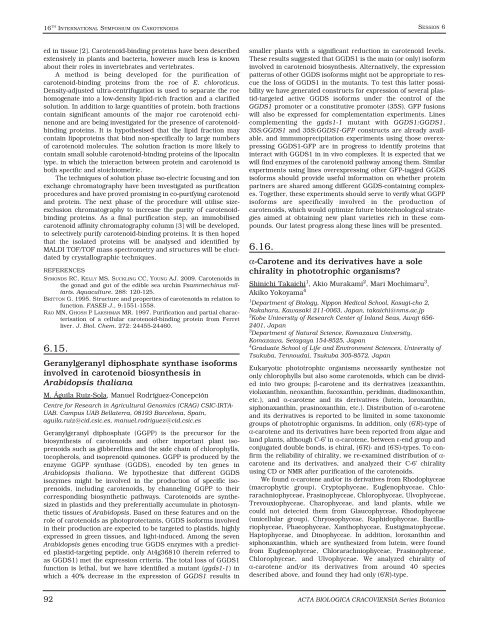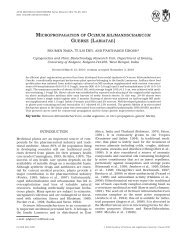ACTA BIOLOGICA CRACOVIENSIA
ACTA BIOLOGICA CRACOVIENSIA
ACTA BIOLOGICA CRACOVIENSIA
You also want an ePaper? Increase the reach of your titles
YUMPU automatically turns print PDFs into web optimized ePapers that Google loves.
16 TH INTERNATIONAL SYMPOSIUM ON CAROTENOIDS<br />
ed in tissue [2]. Carotenoid-binding proteins have been described<br />
extensively in plants and bacteria, however much less is known<br />
about their roles in invertebrates and vertebrates.<br />
A method is being developed for the purification of<br />
carotenoid-binding proteins from the roe of E. chloroticus.<br />
Density-adjusted ultra-centrifugation is used to separate the roe<br />
homogenate into a low-density lipid-rich fraction and a clarified<br />
solution. In addition to large quantities of protein, both fractions<br />
contain significant amounts of the major roe carotenoid echinenone<br />
and are being investigated for the presence of carotenoidbinding<br />
proteins. It is hypothesised that the lipid fraction may<br />
contain lipoproteins that bind non-specifically to large numbers<br />
of carotenoid molecules. The solution fraction is more likely to<br />
contain small soluble carotenoid-binding proteins of the lipocalin<br />
type, in which the interaction between protein and carotenoid is<br />
both specific and stoichiometric.<br />
The techniques of solution phase iso-electric focusing and ion<br />
exchange chromatography have been investigated as purification<br />
procedures and have proved promising in co-purifying carotenoid<br />
and protein. The next phase of the procedure will utilise sizeexclusion<br />
chromatography to increase the purity of carotenoidbinding<br />
proteins. As a final purification step, an immobilised<br />
carotenoid affinity chromatography column [3] will be developed,<br />
to selectively purify carotenoid-binding proteins. It is then hoped<br />
that the isolated proteins will be analysed and identified by<br />
MALDI TOF/TOF mass spectrometry and structures will be elucidated<br />
by crystallographic techniques.<br />
REFERENCES<br />
SYMONDS RC, KELLY MS, SUCKLING CC, YOUNG AJ. 2009. Carotenoids in<br />
the gonad and gut of the edible sea urchin Psammechinus miliaris.<br />
Aquaculture. 288: 120-125.<br />
BRITTON G. 1995. Structure and properties of carotenoids in relation to<br />
function. FASEB J., 9:1551-1558.<br />
RAO MN, GHOSH P LAKSHMAN MR. 1997. Purification and partial characterisation<br />
of a cellular carotenoid-binding protein from Ferret<br />
liver. J. Biol. Chem. 272: 24455-24460.<br />
6.15.<br />
Geranylgeranyl diphosphate synthase isoforms<br />
involved in carotenoid biosynthesis in<br />
Arabidopsis thaliana<br />
M. Águila Ruiz-Sola, Manuel Rodríguez-Concepción<br />
Centre for Research in Agricultural Genomics (CRAG) CSIC-IRTA-<br />
UAB. Campus UAB Bellaterra, 08193 Barcelona, Spain,<br />
aguila.ruiz@cid.csic.es, manuel.rodriguez@cid.csic.es<br />
Geranylgeranyl diphosphate (GGPP) is the precursor for the<br />
biosynthesis of carotenoids and other important plant isoprenoids<br />
such as gibberellins and the side chain of chlorophylls,<br />
tocopherols, and isoprenoid quinones. GGPP is produced by the<br />
enzyme GGPP synthase (GGDS), encoded by ten genes in<br />
Arabidopsis thaliana. We hypothesize that different GGDS<br />
isozymes might be involved in the production of specific isoprenoids,<br />
including carotenoids, by channeling GGPP to their<br />
corresponding biosynthetic pathways. Carotenoids are synthesized<br />
in plastids and they preferentially accumulate in photosynthetic<br />
tissues of Arabidopsis. Based on these features and on the<br />
role of carotenoids as photoprotectants, GGDS isoforms involved<br />
in their production are expected to be targeted to plastids, highly<br />
expressed in green tissues, and light-induced. Among the seven<br />
Arabidopsis genes encoding true GGDS enzymes with a predicted<br />
plastid-targeting peptide, only At4g36810 (herein referred to<br />
as GGDS1) met the expression criteria. The total loss of GGDS1<br />
function is lethal, but we have identified a mutant (ggds1-1) in<br />
which a 40% decrease in the expression of GGDS1 results in<br />
smaller plants with a significant reduction in carotenoid levels.<br />
These results suggested that GGDS1 is the main (or only) isoform<br />
involved in carotenoid biosynthesis. Alternatively, the expression<br />
patterns of other GGDS isoforms might not be appropriate to rescue<br />
the loss of GGDS1 in the mutants. To test this latter possibility<br />
we have generated constructs for expression of several plastid-targeted<br />
active GGDS isoforms under the control of the<br />
GGDS1 promoter or a constitutive promoter (35S). GFP fusions<br />
will also be expressed for complementation experiments. Lines<br />
complementing the ggds1-1 mutant with GGDS1:GGDS1,<br />
35S:GGDS1 and 35S:GGDS1-GFP constructs are already available,<br />
and immunoprecipitation experiments using those overexpressing<br />
GGDS1-GFP are in progress to identify proteins that<br />
interact with GGDS1 in in vivo complexes. It is expected that we<br />
will find enzymes of the carotenoid pathway among them. Similar<br />
experiments using lines overexpressing other GFP-tagged GGDS<br />
isoforms should provide useful information on whether protein<br />
partners are shared among different GGDS-containing complexes.<br />
Together, these experiments should serve to verify what GGPP<br />
isoforms are specifically involved in the production of<br />
carotenoids, which would optimize future biotechnological strategies<br />
aimed at obtaining new plant varieties rich in these compounds.<br />
Our latest progress along these lines will be presented.<br />
6.16.<br />
α-Carotene and its derivatives have a sole<br />
chirality in phototrophic organisms?<br />
SESSION 6<br />
Shinichi Takaichi1 , Akio Murakami2 , Mari Mochimaru3 ,<br />
Akiko Yokoyama 4<br />
1Department of Biology, Nippon Medical School, Kosugi-cho 2,<br />
Nakahara, Kawasaki 211-0063, Japan, takaichi@nms.ac.jp<br />
2Kobe University of Research Center of Inland Seas, Awaji 656-<br />
2401, Japan<br />
3Department of Natural Science, Komazawa University,<br />
Komazawa, Setagaya 154-8525, Japan<br />
4Graduate School of Life and Environment Sciences, University of<br />
Tsukuba, Tennoudai, Tsukuba 305-8572, Japan<br />
Eukaryotic phototrophic organisms necessarily synthesize not<br />
only chlorophylls but also some carotenoids, which can be divided<br />
into two groups; β-carotene and its derivatives (zeaxanthin,<br />
violaxanthin, neoxanthin, fucoxanthin, peridinin, diadinoxanthin,<br />
etc.), and α-carotene and its derivatives (lutein, loroxanthin,<br />
siphonaxanthin, prasinoxanthin, etc.). Distribution of α-carotene<br />
and its derivatives is reported to be limited in some taxonomic<br />
groups of phototrophic organisms. In addition, only (6'R)-type of<br />
α-carotene and its derivatives have been reported from algae and<br />
land plants, although C-6' in α-carotene, between ε-end group and<br />
conjugated double bonds, is chiral, (6'R)- and (6'S)-types. To confirm<br />
the reliability of chirality, we re-examined distribution of αcarotene<br />
and its derivatives, and analyzed their C-6' chirality<br />
using CD or NMR after purification of the carotenoids.<br />
We found α-carotene and/or its derivatives from Rhodophyceae<br />
(macrophytic group), Cryptophyceae, Euglenophyceae, Chlorarachniophyceae,<br />
Prasinophyceae, Chlorophyceae, Ulvophyceae,<br />
Trevouxiophyceae, Charophyceae, and land plants, while we<br />
could not detected them from Glaucophyceae, Rhodophyceae<br />
(unicellular group), Chryosophyceae, Raphidophyceae, Bacillariophyceae,<br />
Phaeophyceae, Xanthophyceae, Eustigmatophyceae,<br />
Haptophyceae, and Dinophyceae. In addition, loroxanthin and<br />
siphonaxanthin, which are synthesized from lutein, were found<br />
from Euglenophyceae, Chlorarachniophyceae, Prasinophyceae,<br />
Chlorophyceae, and Ulvophyceae. We analyzed chirality of<br />
α-carotene and/or its derivatives from around 40 species<br />
described above, and found they had only (6'R)-type.<br />
92 <strong>ACTA</strong> <strong>BIOLOGICA</strong> <strong>CRACOVIENSIA</strong> Series Botanica












